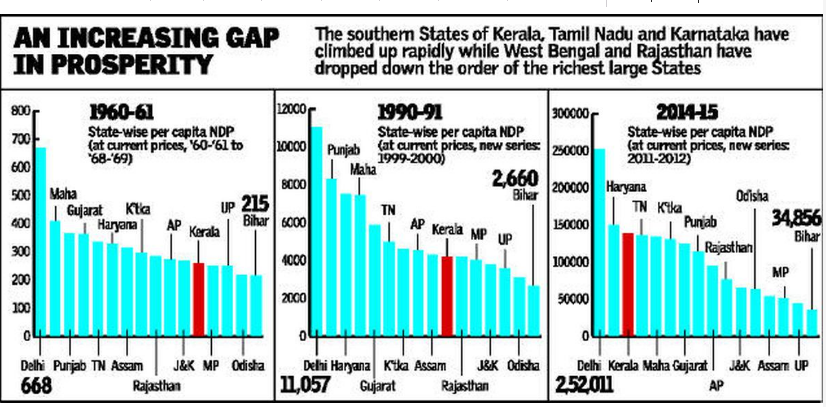Praveen Chakravarty
September 05, 2016

India is the only large country that is experiencing an economic divergence among its States.
“Real freedom lies in economic freedom,” said Tamil Nadu Chief Minister Jayalalithaa, in her Independence Day speech this year. The subtle reference here was to the > Goods and Services Tax (GST) Bill , which her party, the >All India Anna Dravida Munnetra Kazhagam , did not endorse, the only political party to do so in Parliament, on the grounds that it impinged on the fiscal autonomy of the States. She had earlier exhorted the Centre to give “adequate powers to the States”. “These should not be seen as centrifugal or fissiparous trends that have to be curbed, but as a manifestation of India’s maturing as a nation with diversity and as a democracy,” she said.
Clearly, Tamil Nadu and its Chief Minister feel very strongly about their sovereign rights and the imposition of policies from New Delhi. It may be tempting to dismiss this as political grandstanding but Ms. Jayalalithaa is right about the economic diversity of India. Our research of per capita net domestic product from 1960 to 2014 of India’s 12 largest States, that accounted for 85 per cent of the total population, shows that economic disparity within India’s States is among the largest in the world, lending credence to Ms. Jayalalithaa’s demand for economic freedom.
Ranking States In 1960, the average person in West Bengal earned Rs.390 per annum; the average person in Tamil Nadu earned Rs.330. But in 2014, the average Bengali earned Rs.80,000 while the average Tamilian earned Rs.1,36,000. Tamil Nadu went from being the fourth poorest among these 12 States in 1960 to the second richest in 2014. The southern States of Kerala, Tamil Nadu and Karnataka have climbed up rapidly while West Bengal and Rajasthan have dropped down the order of the richest large States. Most of these States started at roughly the same levels of per capita GDP in 1960. In five decades, some have outperformed the rest, leading to a dramatic reshuffle of their ranking.
The more intriguing aspect is the levels and trends of disparity among them. In 1960, the top three States were 1.7 times richer than the bottom three. By 2014, this gap had almost doubled, with the top three States being 3 times richer than the bottom three. The richest (per capita GDP) State in 1960, Maharashtra, was twice as rich as the then poorest State, Bihar. In 2014, the richest state, Kerala, was four times richer than the still poorest state of Bihar. This gap of four times between the richest and the poorest large State in India is among the highest in the world. A similar ratio in other federal polities such as the U.S., European Union and China is between two and three times. Our convergence analysis shows that this economic disparity among States is only widening and not narrowing. India is the only large country in the world today that is experiencing an economic divergence among its States and not convergence, as economic theory would posit.
The seminal year A striking finding of our research is that 1990 is the seminal year that marked a structural break in the gap between the rich and poor States. In the 30-year period between 1960 and 1990, the economic disparity among India’s twelve largest States remained more or less constant. In 1990, the top three States were twice as rich as the bottom three, nearly the same ratio as in 1960. However, in the subsequent 25-year period from 1990 to 2015, the disparity between the richest and the poorest State doubled. Pre-1990 and post-1990 look like almost two different eras in India’s history of economic diversity among States. Economic theory would suggest that the poorer regions grow faster to catch up with the richer States to cause an eventual convergence, as is happening globally. Contrary to global experiences of narrowing disparity, both across and within nations, India actually shows trends of an exacerbating divergence among its large States, implying the richer States will continue to grow faster. What this means is that a child born in Maharashtra today is still likely to be four times richer upon becoming an adult than a child born in Bihar today.
It is clear that the economic outperformance of some of these States is a function of their politics and policies over decades or the “maturation of democracy”, as Ms. Jayalalithaa put it. While it is tempting to attribute explanations for this outperformance, it is very difficult to prove any. At best, it can be attributed to a complex interplay of politics, leadership, policies, human capital, and some luck. Whatever be the reasons, it is quite evident that the priorities of a more prosperous State will be quite different from those that are still very poor. India’s cultural and political diversity is a well-entrenched fact. It is time to accept its economic diversity too. In fact, cultural diversity is what hinders free labour mobility across States. While average income in Tamil Nadu may be four times higher than in Bihar, it is still not easy for a Hindi-speaking, roti-eating Bihari to move to Tamil-speaking, rice-eating Tamil Nadu for a job. Amid such economic disparity among States with varying future needs and priorities, a Delhi-based one-size-fits-all policy regime for all of India is entirely anachronistic. While Ms. Jayalalithaa may have denied any “fissiparous” intent in her demand for more freedom, the struggles of the European Union in balancing common market policies for economically diverse nations should serve as a gentle reminder for an even more diverse India.
Praveen Chakravarty and Vivek Dehejia are Senior Fellows in Political Economy at IDFC Institute, a Mumbai think tank. This is an excerpt from a research briefing paper titled “India’s curious case of economic divergence” to be published by IDFC Institute.
